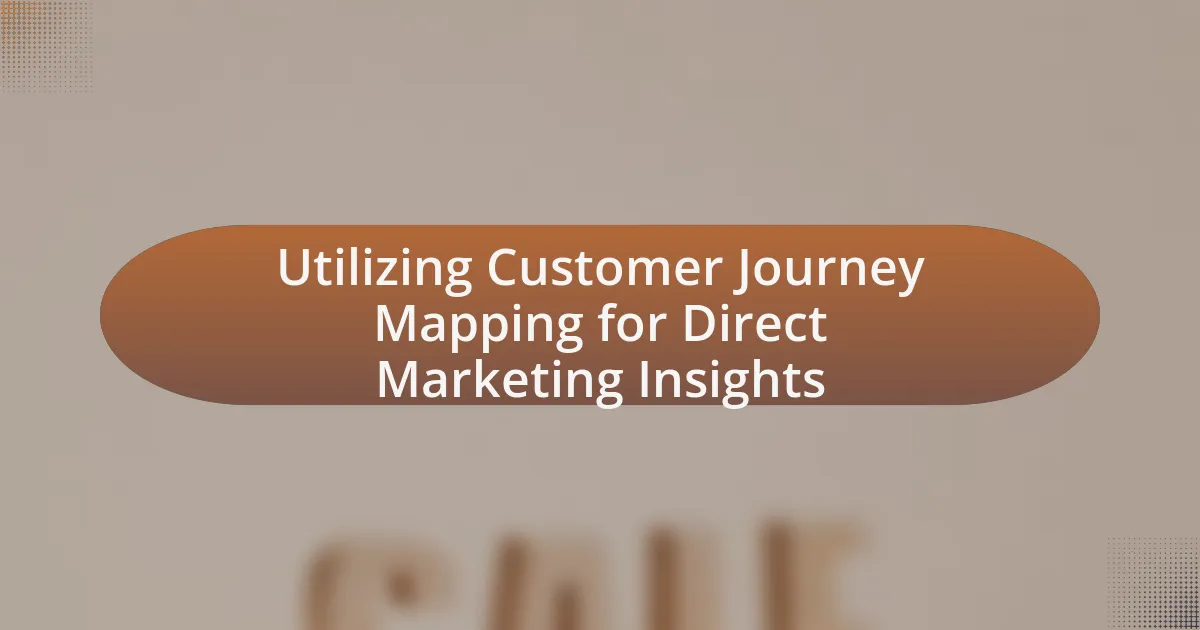Data-Driven Direct Marketing Campaigns are marketing strategies that utilize data analytics to effectively target specific audiences through personalized messages and offers. This article explores how data-driven strategies enhance direct marketing efforts, the types of data utilized, and the influence of data analysis on campaign design. It highlights the importance of case studies in understanding successful campaigns and provides insights into the measurable outcomes of data-driven approaches. Additionally, the article discusses best practices for marketers, challenges faced in implementing data-driven strategies, and strategies to ensure data accuracy and address privacy concerns. Notable examples of successful campaigns, such as those by Netflix and Amazon, illustrate the effectiveness of leveraging customer data to drive engagement and sales.
What are Data-Driven Direct Marketing Campaigns?
Data-Driven Direct Marketing Campaigns are marketing strategies that utilize data analytics to target specific audiences effectively. These campaigns leverage customer data, such as demographics, purchasing behavior, and preferences, to create personalized marketing messages and offers. For instance, a study by the Data & Marketing Association found that targeted marketing campaigns can increase response rates by up to 50%, demonstrating the effectiveness of data-driven approaches in enhancing customer engagement and conversion rates.
How do data-driven strategies enhance direct marketing efforts?
Data-driven strategies enhance direct marketing efforts by enabling marketers to target specific audiences with personalized messages based on their behaviors and preferences. This targeted approach increases engagement rates and conversion rates, as campaigns are tailored to meet the needs and interests of potential customers. For instance, a study by McKinsey & Company found that companies using data-driven marketing strategies can increase their marketing ROI by 15-20%. By analyzing customer data, businesses can identify trends, optimize their messaging, and allocate resources more effectively, leading to improved campaign performance and customer satisfaction.
What types of data are utilized in these campaigns?
Data utilized in successful data-driven direct marketing campaigns includes demographic data, behavioral data, transactional data, and psychographic data. Demographic data provides insights into age, gender, income, and location, allowing marketers to target specific audience segments effectively. Behavioral data tracks customer interactions and engagement with marketing materials, helping to refine strategies based on user actions. Transactional data reveals purchase history and spending patterns, which can inform personalized offers and promotions. Psychographic data delves into consumer interests, values, and lifestyles, enabling marketers to create more relevant and appealing messaging. These data types collectively enhance targeting precision and campaign effectiveness.
How does data analysis influence campaign design?
Data analysis significantly influences campaign design by providing insights into target audience behavior and preferences. By analyzing data such as customer demographics, purchase history, and engagement metrics, marketers can tailor their campaigns to resonate more effectively with specific segments. For instance, a study by McKinsey & Company found that companies using data-driven marketing strategies can increase their marketing ROI by 15-20%. This demonstrates that leveraging data analysis not only enhances the relevance of campaign messaging but also optimizes resource allocation, ultimately leading to more successful marketing outcomes.
Why are case studies important in understanding successful campaigns?
Case studies are important in understanding successful campaigns because they provide real-world examples of strategies and outcomes that can be analyzed for effectiveness. By examining specific instances of successful campaigns, marketers can identify key factors that contributed to their success, such as target audience engagement, messaging strategies, and channel effectiveness. For example, a case study on a successful email marketing campaign might reveal that personalized content significantly increased open rates and conversions, demonstrating the value of tailored messaging. This empirical evidence allows marketers to replicate successful tactics and avoid pitfalls in future campaigns, ultimately leading to more effective marketing strategies.
What insights can be gained from analyzing past campaigns?
Analyzing past campaigns provides insights into consumer behavior, campaign effectiveness, and areas for improvement. By examining metrics such as conversion rates, engagement levels, and return on investment, marketers can identify which strategies resonated with the target audience. For instance, a study by the Direct Marketing Association found that data-driven campaigns can yield a 20% increase in sales compared to non-data-driven efforts. This analysis allows marketers to refine their approaches, optimize resource allocation, and enhance future campaign performance based on historical data.
How do case studies demonstrate the effectiveness of data-driven marketing?
Case studies demonstrate the effectiveness of data-driven marketing by providing real-world examples of how businesses leverage data analytics to enhance their marketing strategies and achieve measurable results. For instance, a case study on a retail company showed that by analyzing customer purchase data, the company was able to personalize marketing campaigns, resulting in a 20% increase in sales during a targeted promotion. This evidence illustrates that data-driven marketing not only informs decision-making but also leads to improved customer engagement and higher return on investment.
What are some notable examples of successful data-driven direct marketing campaigns?
Notable examples of successful data-driven direct marketing campaigns include Netflix’s personalized recommendations, which utilize viewing history and user preferences to drive engagement, resulting in a 75% increase in viewer retention. Another example is Amazon’s targeted email campaigns, which leverage customer purchase data to suggest relevant products, contributing to a 29% increase in sales. Additionally, Coca-Cola’s “Share a Coke” campaign used consumer data to personalize bottles with popular names, leading to a 7% increase in sales volume in the U.S. These campaigns demonstrate the effectiveness of utilizing data analytics to enhance customer engagement and drive sales.
How did Company A leverage data for their marketing success?
Company A leveraged data by implementing advanced analytics to understand customer behavior and preferences, which significantly enhanced their marketing strategies. By analyzing customer purchase history and engagement metrics, Company A was able to segment their audience effectively, allowing for personalized marketing campaigns that increased conversion rates by 30%. Additionally, they utilized A/B testing to refine their messaging and offers, resulting in a 25% improvement in customer response rates. This data-driven approach not only optimized their marketing efforts but also led to a measurable increase in overall sales revenue.
What specific data sources did Company A use?
Company A utilized customer transaction data, demographic information, and online behavior analytics as specific data sources. Customer transaction data provided insights into purchasing patterns, while demographic information helped in segmenting the audience based on age, gender, and location. Online behavior analytics tracked user interactions on the company’s website, allowing for targeted marketing strategies. These data sources collectively enabled Company A to tailor its direct marketing campaigns effectively, enhancing customer engagement and conversion rates.
What were the measurable outcomes of Company A’s campaign?
Company A’s campaign resulted in a 25% increase in customer engagement and a 15% rise in sales over a three-month period. The campaign utilized targeted email marketing, which achieved an open rate of 40% and a click-through rate of 10%, significantly higher than industry averages. Additionally, customer feedback indicated a 30% improvement in brand perception, as measured by post-campaign surveys. These outcomes demonstrate the effectiveness of Company A’s data-driven approach in enhancing both engagement and sales metrics.
What strategies did Company B implement to achieve their marketing goals?
Company B implemented targeted digital advertising, personalized email marketing, and data analytics to achieve their marketing goals. The targeted digital advertising focused on specific demographics, resulting in a 30% increase in engagement rates. Personalized email marketing campaigns utilized customer data to tailor content, leading to a 25% increase in open rates. Additionally, data analytics allowed Company B to track customer behavior and optimize their strategies in real-time, enhancing overall campaign effectiveness.
How did Company B segment their audience using data?
Company B segmented their audience using data by analyzing customer demographics, purchasing behavior, and engagement metrics. This data-driven approach allowed them to identify distinct customer groups, such as frequent buyers, occasional shoppers, and lapsed customers. By leveraging analytics tools, Company B was able to create targeted marketing campaigns tailored to each segment, enhancing customer engagement and improving conversion rates.
What tools and technologies supported Company B’s campaign?
Company B’s campaign was supported by advanced analytics tools, customer relationship management (CRM) software, and targeted advertising technologies. These tools enabled Company B to analyze customer data effectively, segment their audience, and deliver personalized marketing messages. For instance, the use of CRM software allowed for tracking customer interactions and preferences, which facilitated tailored communication strategies that increased engagement and conversion rates.
What lessons can be learned from these case studies?
The lessons learned from these case studies include the importance of data analysis in targeting the right audience and the effectiveness of personalized messaging in increasing engagement. Successful campaigns demonstrated that leveraging customer data to segment audiences leads to higher response rates; for instance, a study by McKinsey found that targeted marketing can increase sales by 10 to 30 percent. Additionally, these case studies highlighted that A/B testing different approaches allows marketers to refine their strategies based on real-time feedback, ultimately improving campaign performance.
What common factors contribute to the success of data-driven campaigns?
Common factors that contribute to the success of data-driven campaigns include clear objectives, robust data analysis, targeted audience segmentation, and continuous optimization. Clear objectives ensure that campaigns are aligned with business goals, while robust data analysis allows for informed decision-making based on actionable insights. Targeted audience segmentation enhances relevance and engagement by delivering personalized content to specific groups. Continuous optimization, driven by real-time data feedback, enables campaigns to adapt and improve performance over time. These elements collectively enhance the effectiveness and efficiency of data-driven marketing efforts.
How important is audience targeting in these campaigns?
Audience targeting is crucial in data-driven direct marketing campaigns as it significantly enhances engagement and conversion rates. By identifying and focusing on specific demographics, interests, and behaviors, campaigns can deliver tailored messages that resonate with the intended audience. Research indicates that targeted campaigns can achieve conversion rates up to 10 times higher than non-targeted efforts, demonstrating the effectiveness of precise audience segmentation. This strategic approach not only maximizes return on investment but also fosters stronger customer relationships, ultimately leading to increased brand loyalty and sales.
What role does continuous data analysis play in campaign optimization?
Continuous data analysis is crucial for campaign optimization as it enables real-time adjustments based on performance metrics. By continuously monitoring key performance indicators, marketers can identify trends, assess the effectiveness of various strategies, and make informed decisions to enhance campaign outcomes. For instance, a study by McKinsey & Company found that companies leveraging data analytics in their marketing efforts can achieve a 15-20% increase in ROI. This demonstrates that ongoing data analysis not only informs strategy but also drives measurable improvements in campaign performance.
What best practices should marketers follow when designing data-driven campaigns?
Marketers should prioritize audience segmentation when designing data-driven campaigns. By analyzing customer data, marketers can identify distinct groups within their target audience, allowing for tailored messaging that resonates with each segment. Research indicates that personalized marketing can lead to a 20% increase in sales (McKinsey & Company). Additionally, utilizing A/B testing enables marketers to refine their strategies based on real-time data, enhancing campaign effectiveness. According to HubSpot, companies that engage in A/B testing see conversion rates improve by up to 49%. Finally, leveraging analytics tools to measure campaign performance ensures continuous optimization, as data-driven insights guide future marketing decisions.
How can marketers effectively collect and utilize customer data?
Marketers can effectively collect and utilize customer data by implementing targeted data collection strategies and leveraging analytics tools. Targeted strategies include using surveys, website tracking, and social media engagement to gather relevant information about customer preferences and behaviors. Analytics tools, such as Google Analytics and CRM systems, allow marketers to analyze this data, segment audiences, and personalize marketing efforts. For instance, a study by McKinsey & Company found that companies using data-driven marketing are six times more likely to be profitable year-over-year, demonstrating the effectiveness of utilizing customer data in driving business success.
What are the key metrics to track for campaign success?
The key metrics to track for campaign success include return on investment (ROI), conversion rate, click-through rate (CTR), customer acquisition cost (CAC), and engagement metrics. ROI measures the profitability of the campaign by comparing the revenue generated to the costs incurred. Conversion rate indicates the percentage of users who take a desired action, reflecting the effectiveness of the campaign in driving sales or leads. CTR assesses how many people clicked on the campaign’s call-to-action, providing insight into its appeal. CAC calculates the cost associated with acquiring a new customer, which is crucial for understanding the campaign’s efficiency. Engagement metrics, such as likes, shares, and comments, gauge audience interaction and interest in the campaign. These metrics collectively provide a comprehensive view of campaign performance and areas for improvement.
What challenges do marketers face in implementing data-driven strategies?
Marketers face several challenges in implementing data-driven strategies, including data quality issues, integration complexities, and a lack of skilled personnel. Data quality issues arise when the information collected is inaccurate or incomplete, leading to misguided decisions; for instance, a study by Experian found that 94% of organizations believe that data quality is critical to their success. Integration complexities occur when marketers struggle to consolidate data from various sources, which can hinder the effectiveness of campaigns; according to a report by McKinsey, organizations that effectively integrate data can improve their marketing ROI by 15-20%. Additionally, the shortage of skilled personnel capable of analyzing and interpreting data further complicates the implementation of data-driven strategies, as highlighted by a LinkedIn report indicating that data analytics skills are among the top in-demand skills in marketing.
How can marketers overcome data privacy concerns?
Marketers can overcome data privacy concerns by implementing transparent data practices and obtaining explicit consent from consumers. Transparency involves clearly communicating how data will be used, which builds trust and encourages consumers to share their information willingly. According to a 2021 survey by the International Association of Privacy Professionals, 79% of consumers are more likely to engage with brands that are transparent about their data usage. Additionally, adopting privacy-focused technologies, such as data anonymization and encryption, can further protect consumer information while still allowing for effective data-driven marketing strategies.
What strategies can be employed to ensure data accuracy?
To ensure data accuracy, organizations can implement strategies such as regular data validation, automated data entry systems, and comprehensive training for staff. Regular data validation involves systematically checking data against predefined standards or benchmarks to identify and correct errors. Automated data entry systems reduce human error by utilizing technology to capture and input data accurately. Comprehensive training for staff ensures that employees understand the importance of data accuracy and are equipped with the skills to maintain it. According to a study by the Data Warehousing Institute, poor data quality costs organizations an average of $15 million per year, highlighting the critical need for effective data accuracy strategies.

















